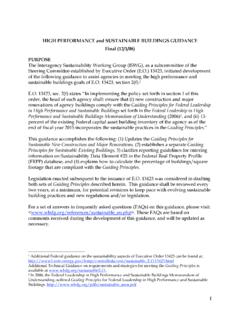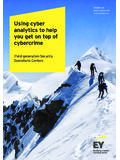Transcription of Sustainability Accounting Standards Board - EY
1 14 ZSustainability Accounting Standards Board By Kelly Gilman and Jess SchulschenkIntroductionThe Sustainability Accounting Standards Board (SASB), a registered non-profit organisation in the United States (US), was officially launched on 4 October 2012. SASB s stated mission is to develop and disseminate industry-specific Accounting Standards for material Sustainability issues for the purposes of integrated reporting. The SASB Standards are suitable for disclosure in standard filings (such the Form 10-K and 20-F in the US context) but are broadly applicable and relevant globally for companies looking to report on material environmental, social and governance (ESG) is developing Standards for 88 industries in 10 sectors using a multi-stakeholder, transparent process.
2 The Standards describe both impacts as well as opportunities for innovation. Taken together they characterise a company s positioning with respect to Sustainability issues and the potential for long term value creation .EvolutionSASB was conceived following research conducted by the Initiative for Responsible Investment (IRI) at Harvard University on determining industry-specific material issues and associated key performance indicators (KPIs) for six industries. After an overwhelming positive response by business to the methodology developed, the idea for an organisation to be established that was the definitive voice for materiality of Sustainability issues and set industry tailored performance indicators for all industries was born.
3 Need for SASBSASB emerges in the midst of growing awareness of the importance of integrating ESG and financial reporting. The practice of integrated reporting is gaining international prominence, with South Africa leading the way through the listing requirement by the Johannesburg Stock Exchange (JSE) that all public companies should produce an annual integrated report (or explain why not). Internationally, many countries are starting to follow suit with regulations coming into play calling for greater integration of financial and non-financial reporting.
4 Furthermore, certain companies have adopted integrated reporting without national regulation requirements, but out of the identified need for and seeing the benefits of more effective and transparent communication of their performance and strategy these trends, there is still a lack of guidance for companies undertaking integrated reporting and a lack of comparability across companies and industries regarding the material issues disclosed. The Global Reporting Initiative (GRI) guidelines developed over a number of years have provided a wide range of Sustainability reporting indicators whilst the International Integrated Reporting Council (IIRC) has been and is working to develop guiding principles for integrated reporting into a solid framework.
5 Professor Bob Eccles, SASB Chairman, notes that The IIRC, whose target user audience is investors, is developing an overall framework for integrated reporting. Standards for financial information will be either IFRS or GAAP. SASB, who is also focused on investors, will provide the Standards for the material nonfinancial information that goes into the integrated report. Complementing integrated reporting is Sustainability reporting to stakeholders which will be based on the upcoming G4 Guidelines from the Global Reporting Initiative.
6 The IIRC, whose target user audience is investors, is developing an overall framework for integrated reporting. Standards for financial information will be either IFRS or GAAP. SASB, who is also focused on investors, will provide the Standards for the material nonfinancial information that goes into the integrated report. Complementing integrated reporting is Sustainability reporting to stakeholders which will be based on the upcoming G4 Guidelines from the Global Reporting Initiative. Professor Bob Eccles SASB Chairman15 Where SASB fits inWhilst SASB is being developed primarily in the US market, the Standards developed are useful for any organisation throughout the world looking to report on Sustainability in an integrated manner.
7 SASB Standards serve two primary stakeholder groups, says SASB Founder and Executive Director Jean Rogers. Through SASB Standards , corporations have a cost-effective way to manage and disclose on the Sustainability issues that are most germane to their industry. Investors have decision useful-information that they can use to benchmark corporate performance on Sustainability issues. SASB collaborates with other organisations to avoid duplication of effort through engagement of various organisations and integrating relevant existing guidance and ideas into its Standards .
8 In this way, SASB is complementary and does not see significant overlap with existing organisations, as reflected in the diagram below:GRI Provides generally applicable Sustainability indicators Each GRI report is unique Companies could consider using SASB Standards to disclose a minimum set of material issues in their integrated report and then prepare a GRI report if broader communication to a wider set of stakeholders is desiredSEC Requires material risk disclosure in Form 10-K and 20-F SASB provides definitive guidance on what these material disclosures should be for ESG issuesIIRC Provides principles for Integrated
9 Reporting, but no prescribed metrics Companies could consider using SASB Standards as the minimum set of disclosures in their integrated reportGISR Mission is to develop a Sustainability rating standard SASB is providing information on material issues so that the GISR may consider materiality in the development of its rating systemSustainability Accounting Standards Board SASBI ndustry specific Sustainability Accounting Standards SASB Standards serve two primary stakeholder groups, through SASB Standards , corporations have a cost-effective way to manage and disclose on the Sustainability issues that are most germane to their industry.
10 Investors have decision useful-information that they can use to benchmark corporate performance on Sustainability issues. Dr. Jean Rogers Founder and Executive Director | SASB16 principles guiding Standards developmentSASB has established various principles to guide the development of the Sustainability Accounting Standards . These include issuing Standards when:1. They are applicable to all investors on an evidence based approach2. They are pertinent and relevant across an industry, again based on robust evidence3.











![Writing Your QAPI Plan [Read-Only]](/cache/preview/b/9/9/8/2/3/f/a/thumb-b99823fa2ae9636b8ed3230c56f78051.jpg)




